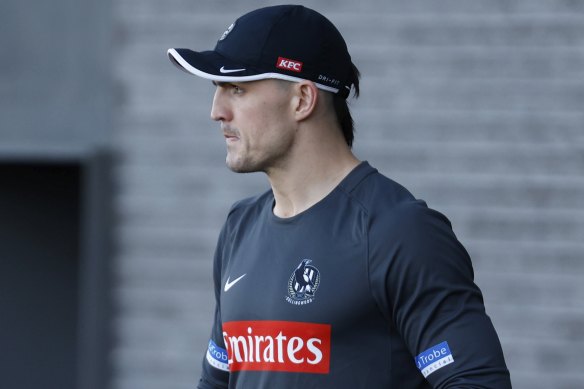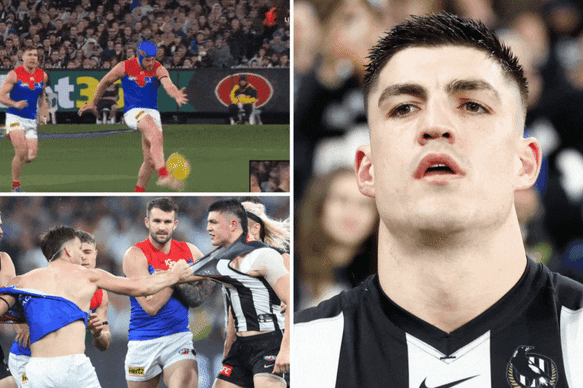Reasonable care, not superhuman perfection: Why Maynard is free to play
Save articles for later
Add articles to your saved list and come back to them any time.
Before delivering Collingwood’s Brayden Maynard from a suspension that could have cost him a grand final and a possible premiership, AFL Tribunal chairman Jeff Gleeson cautioned the footy world against leaping to hysterical conclusions about what this would mean for the future of the game.
Doubtlessly still with images in his mind of the prone and unconscious Angus Brayshaw in the middle of the MCG last Thursday night, conscious that a not guilty verdict would be read in some sections as evidence that footy still does not provide enough protection to its combatants, and perhaps aware that it would be received by some as an invitation to further recklessness, Gleeson said it should not be assumed that this was a watershed in our grasp of a footballer’s duty of care.
Brayden Maynard at Collingwood training on Monday.Credit: Darrian Traynor
Gleeson, remember, was speaking even before he and fellow panellists Darren Gaspar and Scott Stevens had deliberated on the evidence in Maynard’s case. If the decision was to go against Maynard, he seemed to be saying, equally that should not be taken as a reflexive and visceral reaction to what happened to Brayshaw, the game again responding to the outcome of a collision rather than rationally assessing its causes.
Footy being footy, all these and many other imputations will be made anyway.
For all the heat and tension it generated, the charging of Maynard, and now his acquittal, could not be taken as some sort of harbinger of a new and different polity, Gleeson more or less said, because it was so unusual as to be almost unique. Effectively, it was two cases in one. The tribunal had to decide whether Maynard’s failed attempt to spoil Brayshaw was reasonable in the first instance, then whether what it became was an accident or a premeditated bump.
AFL counsel Andrew Woods said that what made the case unusual was also what demonstrated Maynard’s culpability. It began with the decision to try to smother Brayshaw while they were running at speed towards each other. “There will be times, and this is one of them, when it’s just too unsafe to smother in this way,” Woods said.
The incident involving Brayden Maynard and Angus Brayshaw.Credit: Channel Seven / Getty Images
It concluded with airborne, semi-braced Maynard cannoning into Brayshaw and knocking him out in what Woods said was a calculated bump and Maynard said was a reflex. “I turned to land and, shit, he’s there,” he said. “It was almost like a bit of a flinch reaction. Next thing I know, he’s on the floor and I was a bit rattled myself.”
One of few elements not explored in the four-day media blizzard in the prelude, but teased out at the tribunal, was that Maynard and Brayshaw did not collide head-on, but were on slightly off-set trajectories. “Not only is a collision not inevitable, it’s not even likely,” said Maynard’s advocate Ben Ihle. But Brayshaw veered fractionally after kicking the ball. Everyone was quick to note that Brayshaw was not to blame in this.
As is often the case, time became of the essence. When studied frame by frame, Maynard had 0.56 seconds to attempt to smother, to compute that the smother had failed by a fingertip, to absorb that Brayshaw had veered after kicking, and to make another decision to bump rather than collide with Brayshaw with open arms to cushion the impact, as suggested by Woods.
“Based on numbers, based on research, it’s difficult to conclusively say Mr Maynard would have made any conscious decision to reposition his body to bump,” said associate professor Michael Cole, a biomechanist and neuroscientist. “It was more of an innate response. Once in flight, he’s essentially a projectile.”
Noting the split-second timeframe, chairman Gleeson said a footballer was obliged only to demonstrate reasonable care in his decision-making, not superhuman perfection. Little things told: Ihle noted that even as Maynard turned his shoulder reflexively towards Brayshaw, his left hand was forward in a kind of fending motion.
Defending Maynard, Ihle said: “To flinch in that time is not unreasonable, it’s human. It was just one of those unfortunate things that happen from time to time in a high-velocity, high-contact sport. This was unfortunate, this was an accident, but this was not unreasonable contact on Mr Maynard’s behalf.”
In the emotionally highly charged environment of the footy finals, and acknowledging that in footy as much as politics people form their views through the prisms of club allegiances, long-held convictions and visceral likes and dislikes, this verdict will please only half the people. But a guilty judgment would have pleased only the other half.
In the end, the AFL probably got what it wanted. That is, not a full-strength Collingwood in the preliminary final, but a high-profile process and transparent outcome.
If no case had proceeded, as recommended by match review officer Michael Christian, the AFL would have been accused of turning a blind eye. This way, fans can pull apart the case for and against Maynard, and indeed deconstruct the whole ideal of AFL justice, but they can’t complain that it was decided in a deal behind closed doors. Gleeson’s verdict ran to nearly 1100 words.
In ensuring that justice was seen to be done, new AFL footy operations manager Laura Kane has made her first mark.
Keep up to date with the best AFL coverage in the country. Sign up for the Real Footy newsletter.
Most Viewed in Sport
From our partners
Source: Read Full Article

